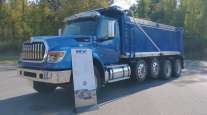Navistar to Adopt Engine with Opposing Pistons
This story appears in the March 14 print edition of Transport Topics.
Truck and engine maker Navistar Inc. has taken a new tack in its drive to offer new motors, joining a company that had developed a radical design that it says offers fuel efficiency and weight improvements.
Navistar said it plans to use the engine’s opposed-piston layout as the basis for “revolutionizing the entire truck architecture,” Eric Tech, president of the company’s Engine Group, told Transport Topics.
John Coletti, CEO of EcoMotors International, an Allen Park, Mich. company founded in 2008 to develop the new engine, said the unit has two opposing cylinders per module, with a crankshaft between them. Each cylinder has two pistons moving in opposite directions, leading to its name: the “opposed-piston opposed-cylinder engine.”
Peter Hofbauer, a former Volkswagen engineer who conceived the OPOC engine, was a founder of Ecomotors and serves as the company’s chairman and chief technical officer.
Microsoft co-founder Bill Gates and venture capital firm Khosla Ventures, Menlo Park, Calif., are principal investors in EcoMotors.
Navistar’s Tech said the truck maker was initially interested in “the potential for a significant increase in fuel efficiency and power density . . . But what particularly captivated me was that it could allow us to develop new vehicle architecture.”
He said Navistar plans to produce both medium- and heavy-duty trucks from the new power plant, which could run on diesel, gasoline or ethanol. Coletti said it would be developed for diesel in commercial vehicles.
Coletti said that Hofbauer is an engineer who spent 20 years with Volkswagen, where he developed VW’s “first high-speed diesel engine.”
The EcoMotors engine “combines the technology of the modern VW Jetta engine with the opposed piston architectural layout that was in a commercial plane during the 1930s,” he said.
In a video on EcoMotors’ website, Hofbauer said his engine “has a lot of advantages because the pistons have to travel only half the distance, and that means the engine can run double the speed, because the speed of the combustion engine is limited by the piston speed. This doubles the power.”
Hofbauer said that advanced computerized electronics vastly increase the engine’s performance from early models developed decades before.
“We have proven results of 15% better fuel efficiency, directly attributable to the OPOC architecture,” Coletti said. “The two major reasons . . . are the lower engine friction and the lower heat rejection to the coolant.”
EcoMotors and Navistar announced the agreement Feb. 22.
“I think that we see opportunities for both the single-module form, which might be thought of as equivalent to a ‘traditional’ 7[-liter] engine, and a dual-module engine that could be thought of as equivalent to a ‘traditional’ 13- to 15[-liter] engine,” Tech said.
“Since this engine architecture changes the game on power density, the best way to think about it is that we could get a 300 [horsepower] in the single module and go to 600 hp within dual-module mode,” he said.
Navistar has plans to get far more than an increase of 15% on fuel efficiency when the engine is perfected and put into a truck, company officials said.
“We see advantages in both the single- and dual-module engines to run trucks, single for medium-duty, dual for heavy-duty,” Tech said.
He said the engine itself would serve as the basis for a completely new truck design.
“If you’re looking at the overall architecture of the vehicle, the engine has only so much influence on fuel efficiency,” Tech said. “We can talk about low axles and so many other factors that this engine would allow us to change, such as the spacing between the trailer and cab. The numbers we’re looking for [in fuel efficiency] are higher than just what EcoMotors has said its engine can do.”
He said that Navistar planned to create “a totally new package around that engine, one that could improve driver visibility, can pack in many safety and comfort components for the driver, and we can increase its aerodynamic efficiency significantly. We could see a complete change in truck architecture, compounding fuel efficiency.”
He said the EcoMotors engine had several advantages.
“It is perfectly balanced, for example,” Tech said. “Each movement of force is countered by equal force elsewhere. There is equal force around the crankshaft. It allows you to have a dual-module makeup without losing fuel efficiency. It also allows for a lot lighter-weight engine. That by itself would make it much less expensive.”
He said that engineers from both companies would begin working on the engine and new truck immediately, but he said Navistar’s exact timeline for introducing the models was confidential.
Tech did say that Navistar probably would begin with versions “at the lighter end of spectrum.”
“It’s the logical place to start,” he said. “We think that in the Class 8 market, it’ll take some time for people in the industry to get comfortable to any new technology, given the nature of their business.”




